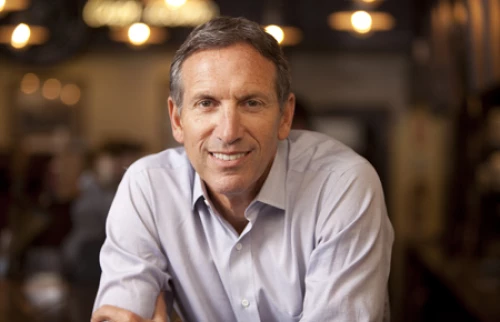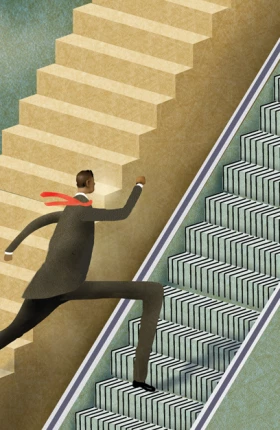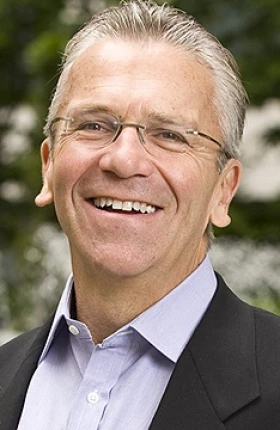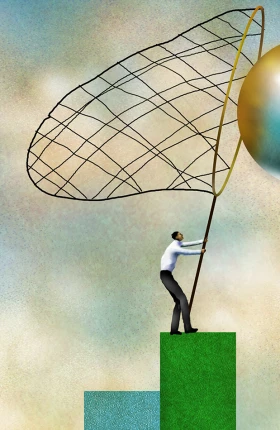Each week Starbucks serves 60 million customers in nearly 18,000 stores in 60 countries. For a company that started as a corner coffee shop in Seattle 41 years ago, those are steamy numbers.
This global growth has been built by carefully tailoring the Starbucks brand to the specific needs of local markets—each with its own traditions, habits, and customs. This is not an easy balancing act, and it all starts with an emphasis on products, “partners” (employees), and customers.
In Beijing and Shanghai, for example, Starbucks recently held an annual meeting for the parents of its employees as a way to demonstrate respect for their families. In the U.K. and France, the company has modified the recipes for its espresso-based drinks to appeal to local tastes—something it had never done before.
CEO Howard Schultz, who has been with Starbucks for most of its history, is painfully aware of what can go wrong when customer focus is lost. Schultz relinquished the chief executive’s role in 2000 but returned in 2008 after changes in stores diluted the customer experience and exacted a heavy toll on the company’s bottom line.
Schultz began rebuilding the brand by reviving the in-store experience. Starbucks spent $30 million to bring 10,000 store managers to New Orleans for a meeting that helped improve employee engagement. He also closed all U.S. stores for three hours one day to retrain the staff in making coffee.
To build on the success of the New Orleans event, Starbucks will hold a similar conference in 2012 in Houston, once again bringing together store managers to engage in leadership activities and community service.
Starbucks recently moved from a functional to a regional structure—instituting regional presidents for the Americas; Asia; and Europe, the Middle East, and Africa—to ensure that local markets receive adequate management attention.
Starbucks has gotten its groove back. Despite the difficulties in Europe, Starbucks has indicated that during the fiscal year 2013 (which begins this month) the company expects to grow by 10 to 13 percent and open 1,200 new stores.
Schultz recently sat down for a discussion with Grant Freeland, a BCG senior partner and managing director. Edited excerpts from that conversation follow.
Few CEOs can claim the success that you have had here at Starbucks. As you reflect on this journey, what would be the highlights?
We have tried to build a different kind of company that would balance profitability and benevolence. The manifestation of that goal—and probably the highlight of my career—has been the creation of two unique benefits for our people: comprehensive health insurance long before the current administration mandated it and equity in the form of stock options.
My father never got a chance to work for a company that respected him. He was an uneducated war veteran. In the back of my mind, I have been trying to build the kind of company that my father never got a chance to work for.
You talk about a two-speed world: high growth in the developing markets, slower growth in the developed markets. How does Starbucks think about growth in those two segments? What are your aspirations, and are you satisfied with where your company is right now?
We are growing as fast as we possibly can in Asia—and specifically in China—because the wind is at our back, and we understand that. In Europe, given the macroeconomic challenges, we have decided to grow in a different way. But we are still growing there. We are going to use and leverage licensing and joint-venture partners rather than company-owned stores in Europe to minimize risk to our own capital. But our commitment to achieving growth and building market share is the same.
How do you make sure that the fast-growing markets that are small relative to the U.S. market receive management’s attention—and do not get smothered by the larger markets?
When a customer goes into a Starbucks store in any small town in America, or, in this case, a smaller country, I do not think he or she is conscious of whether that locale has the infrastructure, the scalability, or perhaps the long-term opportunities of New York City or China in terms of growth and development. We have to view each store on its own merit. We must fund and provide the resources and tools for those smaller markets; otherwise we should never have opened there, and we should go home. I think our commitment to resourcing those markets and providing tools for our people are the same whether we are in China or Cyprus.
Do you have a global incentive program for senior executives to make sure they focus on both? Do you carve out time at senior meetings to make sure that you pay attention to smaller, high-growth countries?
Over the last few months, we changed the way Starbucks is organized. We have created a consumer-packaged-goods business and three regional businesses—the Americas, Asia Pacific, and, finally, Europe, the Middle East, and Africa. We moved from centralized management to four separate presidents managing these four businesses. In a sense, they are the CEOs of their own businesses.
Each one of those business units gets equal time and equal resources because we cannot survive without one or the other. The time spent at meetings is sometimes overly focused on where we have a problem or a crisis, but generally we are managing the businesses equally and with great focus and attention.
How different can the business models be, and how much variation do you allow across the regions?
If the stewards of any consumer brand believe that they can create local relevance while sitting in a white tower somewhere in the U.S.—and dictating the ways in which consumers will react all over the world—they are on a collision course with time. The challenge that we have to understand and overcome is creating the balance between the Starbucks experience that customers all over the world expect and desire and a healthy dose of local relevancy that demonstrates respect for the local customer—whether it is local food, how the stores are designed, pricing, or the tailoring of recipes to local tastes.
For the first time in our history, we just changed the espresso recipe for certain beverages in the U.K. and France. We have never done that before, and I think that is indicative of our commitment to being locally relevant.
I assume that the culture is fairly similar around the world, but with some differences. How much variation do you allow?
We have nearly 200,000 people in 60 countries. There are different languages, customs, politics, and all different types of external issues that we have to integrate into the culture of Starbucks. What I have found—and what perhaps has been the biggest surprise of my life—is that the culture and values of Starbucks are as relevant and as desirable in Jordan, Singapore, and Malaysia as they are in Seattle, Washington. Whether you are an employee or customer, you want to be respected, valued, and treated with dignity.
We just did something in China that I think is one of the most innovative things we have ever done in our history—and it had nothing to do with the customer. It was not customer facing; it was internal. We just had an annual meeting of parents. Think about an annual meeting of shareholders; we had an annual meeting of parents in Beijing and Shanghai, and we had about 90 percent participation. We did not know who or how many would come. In most cases, there were whole families. There were parents, grandparents, aunts, and uncles. It was unbelievable.
We had simultaneous translation. We had demonstrations of what the company is about. We had partners speaking in Mandarin on what it has been like working at Starbucks. Then we had people from other countries expressing their relationships with the company. I spoke about what we are trying to do in China and why. It was a stunning experience.
Beijing was great, and Shanghai was even better because it was bigger, and I think we were better prepared two days later. I think we clearly had some trepidation, but it was a breakthrough for the company and a milestone for local relevancy and sensitivity.
It had nothing to do with marketing or the customer, but everything to do with the equity of the brand and the culture and values of the company. It was as locally relevant as anything we have ever done. And yet it was part of the culture and fabric of our 40-year history.
Are you going to have these meetings in other countries?
I cannot think of how many parents would show up in America. And I think that says something, doesn’t it? I think we will do it every year in China. I just told a major U.S. retailer about it, and I think they may do it, too.
That relates to attracting talent, which is a global issue. Have you had challenges recruiting in developing and high-growth markets?
The short answer is that we have not had trouble attracting and retaining great people. The issue for us is getting the right people in the right positions. There is quite a debate inside Starbucks today about expats. It is hard to build an organization with people who are not imprinted with the history of Starbucks. So, by and large, we have sent a lot of people overseas to help build the organization. It turns out that this approach is extraordinarily expensive. There is a tradeoff. Those companies that do it very well—and I do not think we are there yet—have built a pipeline of people at the local level, and that is what we need to do.
The days of exporting products and ideas from developed countries to developing countries are over. In fact, some people say we can learn from developing markets. Do you find that true? How do you think about a global rollout of ideas?
The real challenge is creating disruptive innovation that changes the market and that gives people real value and significant opportunity to enhance their lives, whatever the product or category. I will be a sponge absorbing any innovative idea, product, or category from any part of the world. We have certainly benefited from certain flavors and categories that we have brought over from Asia. I think that the lifeblood of trying to grow an enterprise is truly creating innovative, breakthrough, disruptive ideas. But I would not want to put a label on whether or not those can or should not come from one place or the other.
How much time do you and the leadership team spend outside the U.S., particularly in developing economies?
If I looked at my calendar the past 12 months, I think I was traveling maybe 30 to 40 percent of the time. And I would say 80 percent of that travel was outside the U.S. You go where the opportunity, crisis, or challenge is.
How do you connect with nearly 200,000 partners?
It is very hard, really hard. We are a company that benefits from physical meetings and being in close touch with our people, so it requires a tremendous amount of travel. We instituted something, maybe 20 years ago, that we call “open forums.” Every quarter, all over the world, we stand up in front of all of our partners and talk about the past quarter’s accomplishments. It is an open environment, almost like a town hall meeting with an open microphone. Our people are talking to us about their ideas, concerns, and complaints—any issue whatsoever. There is no net for the leader because you do not know what is coming. There’s no retribution. I think it has built a groundswell of trust and understanding within the company.






